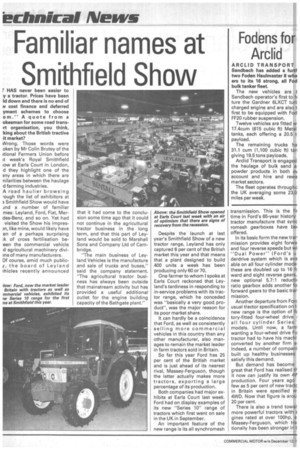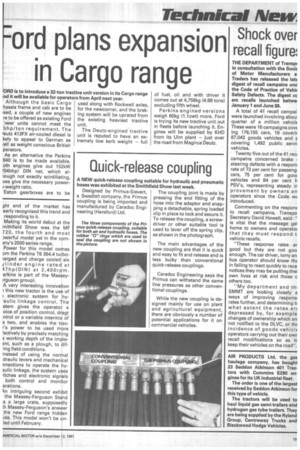Familiar names at Smithfield Show
Page 10

Page 11

If you've noticed an error in this article please click here to report it so we can fix it.
r HAS never been easier to y a tractor. Prices have been Id down and there is no end of N cost finance and deferred yment schemes to choose om.— A quote from a okesman for some road transrt organisation, you think, lking about the British tractive It market?
Wrong. Those words were oken by Mr Colin Brutey of the itional Farmers Union before it week's Royal Smithfield low at Earls Court in London, d they highlight one of the any areas in which there are nilarities between the haulage d farming industries.
A road haulier browsing .ough the list of exhibitors at a Smithfield Show would have -Ind a number of familiar mes: Leyland, Ford, Fiat, Mendes-Benz, and so on. Yet had visited the Show his impresm, like mine, would likely have en of a perhaps surprising ;k of cross fertilisation beeen the commercial vehicle d agricultural machinery divims of many manufacturers.
Of course, amid much publicj, the board of Leyland :hides recently announced that it had come to the conclusion some time ago that it could not continue in the agricultural tractor business in the long term, and that this part of Leyland would be sold to Marshall Sons and Company Ltd of Cambridge.
"The main business of Leyland Vehicles is the manufacture and sale of trucks and buses," said the company statement. "The agricultural tractor business has always been outside that mainstream activity but has provided a useful additional outlet for the engine building capacity of the Bathgate plant." Despite the launch at last year's Smithfield Show of a new tractor range, Leyland has only captured 6 per cent of the British market this year and that means that a plant designed to build 400 units a week has been producing only 60 or 70.
One farmer to whom I spoke at Earls Court reckoned that Leyland's tardiness in responding to in-service problems with its tractor range, which he conceded was "basically a very good, product", was the major reason for its poor market share.
It can hardly be a coincidence that Ford, as well as consistently selling more commercial vehicles in this country than any other manufacturer, also manages to remain the market leader in farm tractors sold in Britain.
So far this year Ford has 25 per cent of the British market and is just ahead of its nearest rival, Massey-Ferguson, though the latter actually makes more tractors, exporting a large percentage of its production.
Both companies had major exhibits at Earls Court last week. Ford had on display examples of its new "Series 10" range of tractors which first went on sale in the UK in September.
An important feature of the new range is its all synchromesh transmission_ This is the fir time in Ford's 65-year history tractor manufacture that syhc romesh gearboxes have 604 offered.
In its basic form the new trer mission provides eight forma and four reverse speeds but wi "Dual Power" (Ford's u derdrive system which is aya able on all four cylinder mode these are doubled up to 16 ,fic ward and eight reverse gears. new optional 5.7:1 reductir ratio gearbox adds another fo forward gears to the basic trotmission.
Another departure from Farr usual tractor specification od t: new range is the option of .fi• tory-fitted four-wheel drive4 all four cylinder Series ' models. Until now, a fartr wanting a four-wheel drive lo tractor had to have his ma0i converted by another firm ,a1 indeed, a number of compahi built up healthy businessee satisfy this.demand.
But demand has become great that Ford has realised ttr it now can justify its own 4V production. Four years agli few as 5 per cent of new tralitc in Britain were specified iry 4WD. Now that figure is arqu 20 per cent.
There is also a trend tower more powerful tractors with E gines rated at over 100hp, ;a Massey-Ferguson, which tra tionally has been stronger in t
ght end of the market has early recognised this trend and responding to it.
Making its world debut at the mithfield Show was the MF 720, the fourth and most )werful model yet in the corn3ny's 2000 series range.
Power for this model comes Dm the Perkins T6 354.4 turbolarged and charge cooled six ilinder engine rated at 17 hp(DIN) at 2,4 0Orpm. erkins is part of the Masseyrrguson group).
A very interesting innovation ) this new tractor is the use of electronic system for hy
• aulic linkage control. The stem gives the operator a oice of position control, dragt ntrol or a variable intermix of e two, and enables the tracr's power to be used mbre 'ectively by precisely matching a working depth of the impleant, such as a plough, to dif-ing field conditions.
Instead of using the normal draulic levers and mechanical nnections to operate the hy3ulic linkage, the system uSes 'itches and electronic signals
both control and monitor erations.
intriguing second exhibit the Massey-Ferguson Stand s a large crate, supposedly :h Massey-Ferguson's answer the new Ford range hidden ide. This model won't be unled until February.










































